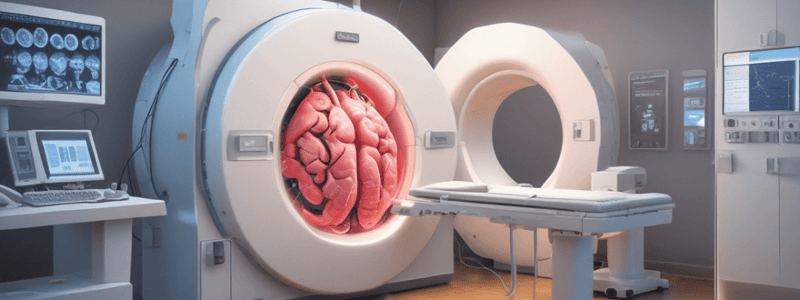Podcast
Questions and Answers
What is the primary advantage of using F-18 fluorodeoxyglucose (FDG) in positron emission tomography (PET) compared to Single-photon emission computed tomography (SPECT)?
What is the primary advantage of using F-18 fluorodeoxyglucose (FDG) in positron emission tomography (PET) compared to Single-photon emission computed tomography (SPECT)?
- Better anatomical localization
- Reduced scan time
- Higher contrast and spatial resolution (correct)
- Lower radiation exposure
In PET-CT imaging for cancer detection, what is the main reason for combining PET with CT?
In PET-CT imaging for cancer detection, what is the main reason for combining PET with CT?
- To speed up the scanning process
- To improve anatomical localization and provide detailed metabolic information (correct)
- To reduce patient discomfort
- To decrease radiation exposure
How does Single-photon emission computed tomography (SPECT) differ from Positron emission tomography (PET) in terms of the radioisotopes used?
How does Single-photon emission computed tomography (SPECT) differ from Positron emission tomography (PET) in terms of the radioisotopes used?
- PET uses gamma-emitting radioisotopes (correct)
- PET uses tracers like technetium-99m
- SPECT uses tracers with better contrast and resolution
- SPECT uses positron-emitting radioisotopes
For normal tissue and organ mapping in PET-CT, what advantage does Single-photon emission computed tomography (SPECT) have over Positron emission tomography (PET)?
For normal tissue and organ mapping in PET-CT, what advantage does Single-photon emission computed tomography (SPECT) have over Positron emission tomography (PET)?
In the context of PET-CT imaging, what role does attenuation correction play in the scanning process?
In the context of PET-CT imaging, what role does attenuation correction play in the scanning process?
What is the primary purpose of using PET-CT imaging in cancer detection?
What is the primary purpose of using PET-CT imaging in cancer detection?
How can PET-CT imaging be used to stage cancer?
How can PET-CT imaging be used to stage cancer?
What is the role of PET-CT imaging in evaluating the response to cancer treatment?
What is the role of PET-CT imaging in evaluating the response to cancer treatment?
How is a PET-CT procedure performed for cancer imaging?
How is a PET-CT procedure performed for cancer imaging?
How can PET-CT imaging be used to map normal tissues and organs in the body?
How can PET-CT imaging be used to map normal tissues and organs in the body?
What is the significance of the radioactive tracer used in PET-CT imaging?
What is the significance of the radioactive tracer used in PET-CT imaging?
What is the primary use of PET-CT imaging in cancer management?
What is the primary use of PET-CT imaging in cancer management?
How does PET-CT imaging help in staging cancer?
How does PET-CT imaging help in staging cancer?
Which radioactive material is commonly used in PET-CT imaging for cancer detection?
Which radioactive material is commonly used in PET-CT imaging for cancer detection?
What is the primary advantage of PET-CT imaging over other imaging techniques?
What is the primary advantage of PET-CT imaging over other imaging techniques?
Which of the following is NOT a common use of PET-CT imaging?
Which of the following is NOT a common use of PET-CT imaging?
How is the radioactive material administered to the patient during a PET-CT scan?
How is the radioactive material administered to the patient during a PET-CT scan?
Flashcards are hidden until you start studying
Study Notes
SPECT-CT Reconstruction
- Projection data from cameras is reconstructed into 3D images in axial slices
- SPECT-CT provides attenuation correction and higher resolution anatomical localization
SPECT vs PET
- SPECT and PET are nuclear medicine imaging techniques that provide metabolic and functional information
- They can be combined with CT and MRI to provide detailed anatomical and metabolic information
Positron Emission Tomography (PET)
- Uses positron-emitting radioisotope (tracer) such as F-18 fluorodeoxyglucose (FDG)
- Provides better contrast and spatial resolution compared to SPECT
- Has a ring of multiple detectors
Single-Photon Emission Computed Tomography (SPECT)
- Uses gamma-emitting radioisotope (tracer) such as technetium-99m, iodine-123, or iodine-131
- Provides poorer contrast and spatial resolution compared to PET
- Usually uses one large crystal-based detector
Positron Emission Tomography/ PET-CT
- Utilizes the advantages of both PET and CT
- Nuclear medicine uses small amounts of radioactive material called radiotracers to diagnose, evaluate, and treat various diseases
- Radiotracers accumulate in tumors or regions of inflammation and can bind to specific proteins in the body
Radiotracers
- The most common radiotracer is 2-[F-18]fluoro-2-deoxy-D-glucose (FDG), a molecule similar to glucose
- Fluorine-18 is an unstable radioisotope with a half-life of approximately 110 minutes
- Cancer cells are more metabolically active and may absorb glucose at a higher rate
PET-CT Procedure
- Ordinary x-ray exams pass x-rays through the body to create an image
- Radioactive materials (F-18 fluorodeoxyglucose) are injected intravenously, or swallowed or inhaled as a gas
- The material accumulates in the area under examination, giving off gamma rays
- Special cameras detect this energy and create pictures with the help of a computer
Uses of PET-CT
- Detect cancer and/or make a diagnosis
- Determine whether a cancer has spread in the body
- Stage cancer which potentially can be treated radically
- Establish baseline staging before commencing treatment
- Determine if a cancer has returned after treatment
- Evaluate prognosis
- Assess tissue metabolism and viability
- Map normal human brain and heart function
- Assess response to therapy
- Evaluate suspected disease recurrence, relapse, and/or residual disease
Studying That Suits You
Use AI to generate personalized quizzes and flashcards to suit your learning preferences.



